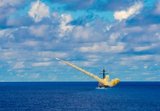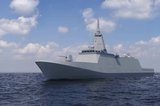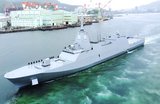Euronaval 2022: Safran launches Vigy 4 surface ship optronic system
Safran's Vigy 4 optronic system. (Photo: Safran)
At Euronaval 2022 in Paris, Safran launched the Vigy 4, a new optronic system for surface ships.
The system is the latest addition to the company’s line of naval optronic sensors, including the Vigy HD and Paseo XLR systems.
The Vigy 4 is described as a compact gyro-stabilised multi-sensor system with a shortwave infrared channel for seeing through mist and fog.
The new camera system has observation and fire control capabilities to meet the needs of smaller ships such as OPVs and Corvettes.
Shephard understands launch customers are in place for the new system.
The Vigy 4 is designed with the ability to control light and medium-calibre weapons.
More from Naval Warfare
-
![US Navy advances with the Harpoon Service Life Extension Programme]()
US Navy advances with the Harpoon Service Life Extension Programme
The US Navy plans to improve Harpoon’s anti-ship and land attack capabilities by equipping the missiles with sensors and technologies required for succeeding in future battlespace.
-
![Mitsubishi eyes future with Australia’s Mogami selection]()
Mitsubishi eyes future with Australia’s Mogami selection
With Australia’s selection of the Mogami-class for Project Sea 3000, Mitsubishi is investigating local production in the next decade as potential export opportunities emerge.
-
![Hanwha wins Australian government approval to increase its stake in Austal]()
Hanwha wins Australian government approval to increase its stake in Austal
The contract would mean the two shipbuilders can collaborate strategically and enhance shipbuilding capabilities in Western Australia.
-
![Royal Australian Navy sizes up modernisation plans for new and existing capabilities]()
Royal Australian Navy sizes up modernisation plans for new and existing capabilities
The Australian navy is pushing ahead with its efforts to modernise its workforce and capabilities while balancing risky submarine upgrades, ageing Collins-class boats and a shrinking minehunter fleet. Head of navy capability RAdm Stephen Hughes updated Shephard on the force’s progress.






















